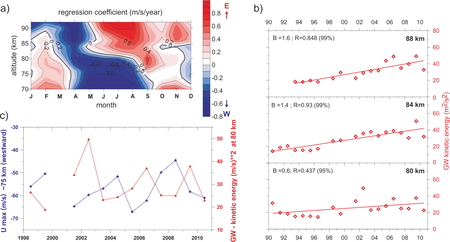Research
- Research Topics
- Department Optical and Rocket Soundings
- Department Radar Remote Sensing
- Department Modelling of Atmospheric Processes
- Working Group Satellite Data Analysis
- Cross-departmental Collaborations
- Projects
- Publications
Trend studies with radar/radio instruments
Investigations of long-term trends in the Earth’s atmosphere are important due to scientific and political reasons, given that such trends may be related to anthropogenic influences. One important aspect consists in the separation between long-term trends and variations caused by the 11-year solar cycle. Our trend analyses are mainly carried out with the following radar/radio observations of the MLT and Ionospheric regions:
- MLT wind observations at mid latitudes (Juliusruh) and at polar latitudes (Andenes). Trends are derived from the prevailing winds and their variations caused by atmospheric waves with periods from minutes up to several days, with special emphasis on gravity waves.
- Mesospheric reflection heights from low frequency radio links from more than 50 years of continuous observations. The derived atmospheric pressure changes are related to temperature changes below approx. 82 km.
- Mean mesospheric neutral density derived from the daily peak altitude distributions of specular meteor echoes.
- Occurrence (frequency, strength, and duration) of mesospheric echoes during summer at polar (PMSE) and mid-latitudes (MSE). Observed trends in these occurrences might be related to temperature and/or water vapour trends at the mesospheric altitudes.
- Peak densities and heights from E and F region using more than 50 years of continuous observations with the Juliusruh ionosonde.
Our studies are accompanied by model results, trying to find out if the detected trends could be caused by the known increases of the atmospheric greenhouse gases (CO2, CH4, O3, H2O…).

Publications
- P. Hoffmann, M. Rapp, W. Singer und D. Keuer, Trends of mesospheric gravity waves at northern middle latitudes during summer, J. Geophys. Res., doi:10.1029/2011JD015717, 2011.
- R. Latteck und J. Bremer, Long-term changes of polar mesosphere summer echoes at 69°N, J. Geophys. Res., doi:10.1002/jgrd.50787, 2013.
- J. Mielich und J. Bremer, Long-term trends in the ionospheric F2 region with different solar activity indices, Ann. Geophys., 31, 291-303, doi:10.5194/angeo-31-291-2013, 2013.
- W. Singer, P. Hoffmann, G. Kishore Kumar, N. J. Mitchell und V. Matthias, Atmospheric coupling by gravity waves: Climatology of gravity wave activity, mesospheric turbulence and their relations to solar activity, in Climate And Weather of the Sun-Earth System (CAWSES): Highlights from a priority program, Springer, F.-J. Lübken, Dordrecht, The Netherlands, doi:10.1007/978-94-007-4348-9, 2012
- G. Stober, V. Matthias, P. Brown und J. L. Chau, Neutral density variation from specular meteor echo observations spanning one solar cycle, Geophys. Res. Lett., Submitted, 2014.
- D. Offermann, P. Hoffmann, P. Knieling, R. Koppmann, J. Oberheide und W. Steinbrecht, Long-term trends and solar cycle variations of mesospheric temperature and dynamics, J. Geophys. Res., 115, D18127, doi:10.1029/2009JD013363, 2010.
- J. Bremer, P. Hoffmann, R. Latteck, W. Singer und M. Zecha, Long-term changes of (polar) mesosphere summer echoes, J. Atmos. Solar-Terr. Phys., 1571-1576, doi:10.1016/jastp.2009.03.010, 2009.
- R. Latteck und J. Bremer, Long-term variations of polar mesospheric summer echoes observed at Andøya 69°N, J. Atmos. Solar-Terr. Phys., 163, 31-37, doi:10.1016/j.jastp.2017.07.005, 2017.












